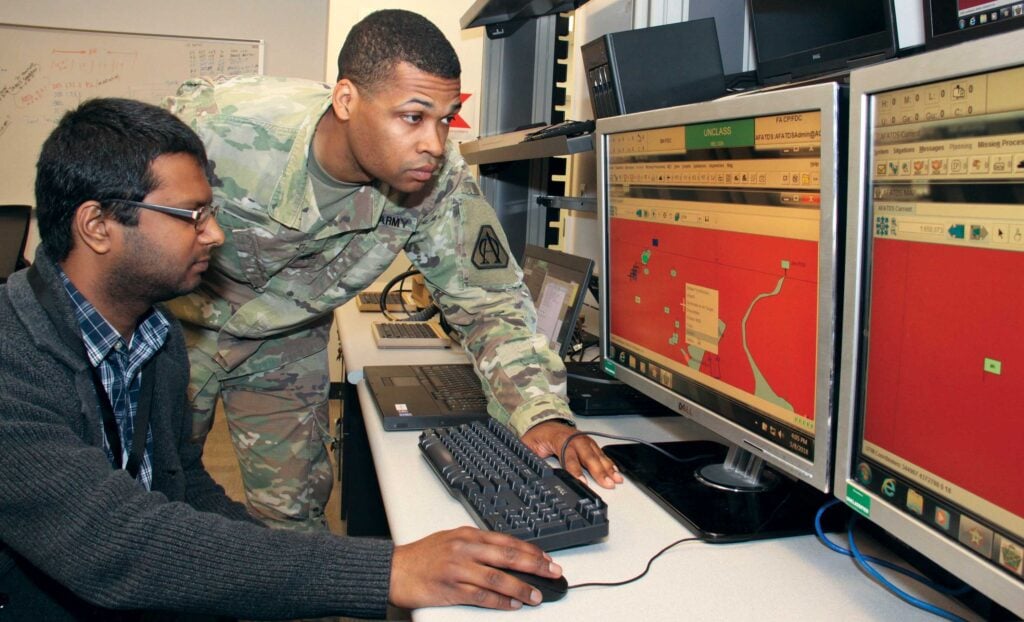SYDNEY J. FREEDBERG JR.

You have to catalog your data, figure out what really matters and is authoritative, excise what’s unreliable or irrelevant, and then experiment to figure out what different decision-makers at different levels really need to do their jobs, said David Markowitz, who became CDO last fall. If you don’t prioritize, he warned, then trying to share everything will overwhelm users and networks alike.
That’s especially true for frontline units, because they can’t trail fiber optic cables from the battlefield back to giant server farms: They have to rely on tactical wireless networks that high-tech adversaries like Russia or China will attack.
“It is one thing to build data services within a cloud environment where you have very large bandwidth; it’s another at the tactical edge that may be disrupted in a near-peer environment,” Markowitz said. “[The goal is] getting the right level of data, accessibility and data services that won’t clog that tactical edge.”
Army Chief Data Officer David Markowitz addresses the AFCEA NOVA “Army IT Days” conference.
Clogging the pipes is a very real danger, even for well-connected headquarters in the United States. Consider the Army’s HR bureaucracy, Human Resources Command. While half their legacy systems are now being consolidated into the Integrated Personnel and Pay System – Army (IPPS-A), half of them are not.
“The half that remain [have] 800,000 data elements,” Markowitz said. “[But] when you look to find which ones are really needed, it’s about 5,000. [So] what is really the authoritative data? Do you need to know 800,000? Or do you need to know 5,000? That’s a huge sea change in simplifying data.
To lay the foundation for that simplification across the Army, “we’re establishing an enterprise data catalogue,” he said. The goal is not to capture “all the data,” he said, but the “prioritized, authoritative data” that Army organizations actually need, with a clear “pedigree” to ensure data is accurate and access controls to keep that data secure.
The Army wants to share multiple types of information, from real-time targeting data – for both physical strikes and cyber/electronic attacks – to personnel records, maintenance diagnostics and digital blueprints for 3D printing. It wants to share the data with the other services and foreign allies, part of the Pentagon’s push for Combined & Joint All-Domain Command & Control (C-JADC2). It wants to share data from satellites and drones to howitzers, as in the Project Convergence wargames. And it wants to share data from US bases to frontline units as it links its enterprise and tactical networks.
Multi-Domain Operations, or All Domain Operations, envisions a new collaboration across land, sea, air, space, and cyberspace (Army graphic)
That focus on the tactical level – where getting the right data at the right time can be a matter of life or death – marks a change of emphasis for the Army’s data strategy, Markowitz said.
“[We] initially thought that our enterprise data analytics would be really a headquarters function supporting senior leaders,” he said, and that’s still important – but it’s not the only important thing.
Instead, he said, “we’re finding we’re getting some of our best return” by pushing relevant data to decision-makers at lower echelons. That could be contracting officers trying to track obligated and unobligated funds, infantry company commanders making health and readiness assessments of their soldiers, or division staff officers coordinating a call for artillery fire, he said.
Army leaders have starting saying that, in the future AI-driven fight, data is the new ammunition. Markowitz agrees – but, he added, that means you need to handle data as carefully as live ammo, Markowitz warned, not spray it all over the place. That means a careful plan to build it, distribute it, protect it, and, when necessary, dispose of it securely.
No comments:
Post a Comment